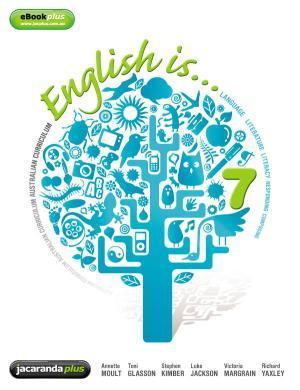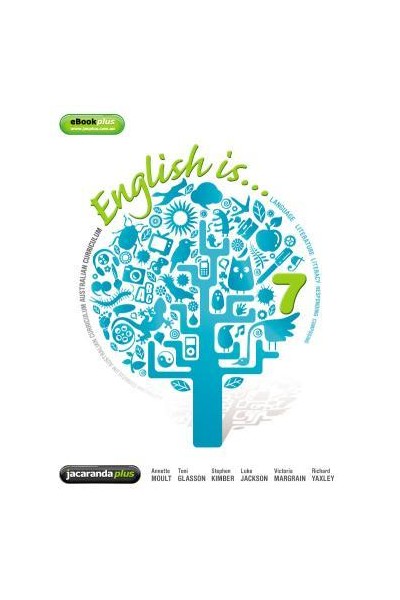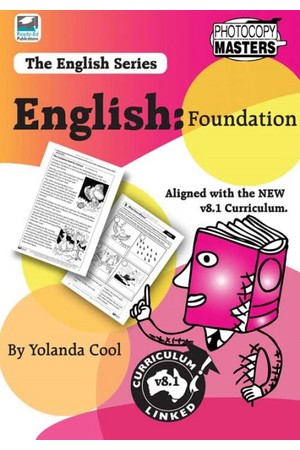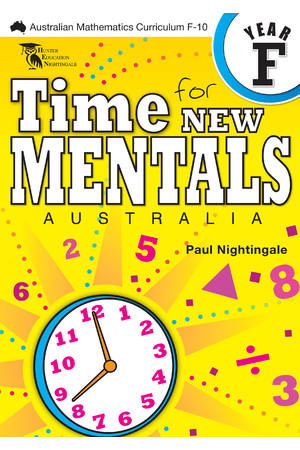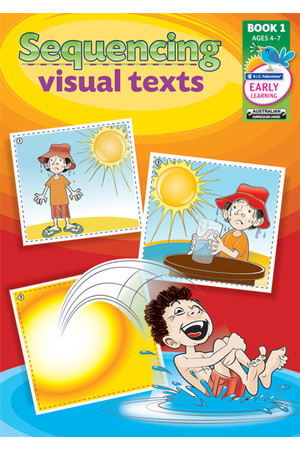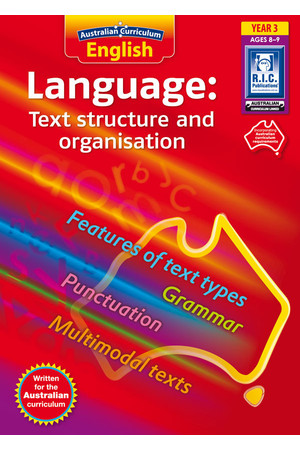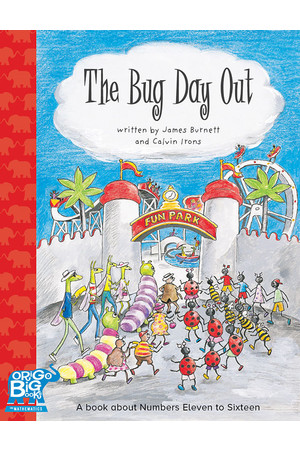Part of the series English Is... English for the Australian Curriculum Year 7.
View all products in this series

English Is ... English for the Australian Curriculum Year 7 & eBookPLUS
KEY FEATURES- Full coverage of the Australian Curriculum: English content descriptions allows students to achieve year level standards
- The text is always at the centre of the learning
- Differentiated activities provide all students with an entry point to the texts through a Getting started, Working through and Going further grading
- Sub-unit structure allows for a dip-in, dip-out approach
- Wordsmiths or mini-workshops drill down to teach key skills in a Tell me, Show me, Let me do it process
- Ready to Read prepares less able readers to engage with the texts
- Asian and Indigenous texts are featured along with classic, world, Australian and contemporary texts
- 'Need to know' explains key terms at point of need so that students learn English's metalanguage
- Language, Literature and Literacy links connect to the Australian Curriculum content descriptions
- Wide variety of assessment options at the end of every unit with rubrics to guide students
- Access from any digital device: PC/MAC/iPad/Android Tablet.
- Worksheets - Word documents designed for easy customisation and editing.
- Interactivities and games to reinforce and enhance student learning.
- eLessons - engaging video clips and supporting material.
- Weblinks to relevant support material on the internet.
- ProjectsPLUS - unique ICT-based projects that provide opportunities for students to demonstrate creativity, thinking skills and teamwork.
Contents
- UNIT 1 My world, your world 1
- How does literature help us to understand about culture?
- Literature and culture 3
- Tuning in 3
- 1.1 Stories from other places, other cultures 4
- What can stories of people’s lives tell us about the culture and customs of other countries?
- Wordsmith . . . Evaluative language 10
- 1.2 Poetry and culture 12
- How can poetry help us to understand a country’s traditional culture? 12
- Haiku 12
- A traditional Australian bush poem 14
- Wordsmith . . . Critical analysis of a poem 17
- 1.3 Other times and culture 18
- What can stories based on historical events tell us about life in other times? 18
- Wordsmith . . . What is an idiom? 23
- Compose and create 24
- UNIT 2 Culture remix 27
- How does today’s culture draw on stories from other times and places?
- What is popular culture? 29
- Tuning in 29
- 2.1 Stories and culture 30
- How does manga tell stories? 30
- Wordsmith . . . Steps in creating Manga or a comic book 37
- 2.2 Popular culture retells our past 39
- What is the significance of stories from the past? 39
- A Holocaust story 39
- Inside Hana’s Suitcase — an interactive web story 42
- Wordsmith . . . Understanding concrete and abstract nouns 45
- 2.3 Popular culture retells our present 46
- How can a story from China be transformed from one form to another? 46
- The novel form 46
- The picture book form 48
- The film form 50
- Wordsmith . . . The grammar of visual texts 53
- Compose and create 56
- UNIT 3 The writer’s craft 59
- What is a writer’s ‘craft’?
- What does it mean to ‘craft’? 61
- Tuning in 61
- 3.1 Crafting language in imaginative texts 62
- How do writers appeal to a reader’s senses in poetry? 62
- Haiku: short but full of sensation 62
- Mood poetry 65
- Wordsmith . . . Creating mood with your senses 66
- 3.2 Crafting language in prose fiction 68
- How do prose writers evoke a response from a reader? 68
- Wordsmith . . . Writing to craft mood 71
- 3.3 Crafting multimodal texts 78
- How do web designers craft web pages? 78
- Wordsmith . . . Crafting texts using verbs 82
- Compose and create 84
- UNIT 4 Narrative worlds 87
- How do narratives capture an imagined world?
- Understanding the what and how of storytelling 89
- Tuning in 89
- 4.1 Setting creates narrative worlds 90
- How do writers create vivid and engaging settings? 90
- Creating settings in visual narratives 93
- Wordsmith . . . Choose language to create impact 99
- 4.2 Characters create narrative worlds 100
- How do characters bring a story to life? 100
- Characters of myth and fairytale 100
- Action and reaction in characters 104
- Wordsmith . . . Writing effective dialogue 108
- 4.3 Narrative viewpoint 110
- How do writers use ‘point of view’ to position the reader? 110
- Point of view in multimodal texts 114
- Wordsmith . . . From third person to first person 118
- Compose and create 120
- UNIT 5 The play’s the thing 123
- How does drama tell stories?
- How is drama part of our lives? 125
- Tuning in 125
- 5.1 Understanding plays as texts 126
- What are the key features of a play? 126
- The playscript 126
- How are plays structures? 130
- Wordsmith . . . What is subtext? 136
- 5.2 Understanding characters in plays 137
- How do plays make us engage with their characters? 137
- Desire and obstacle 137
- Monologues 139
- Wordsmith . . . Distinguishing fact from opinion 142
- 5.3 Performing plays 143
- How can we create a dramatic performance? 143
- Becoming the character 143
- Who, where, what, if 143
- Knowing characters 143
- Discovering the character 145
- Understanding back-story 146
- Blocking, rehearsing and performing 147
- Working with tone 150
- Wordsmith . . . Writing your own scene 152
- Compose and create 154
- UNIT 6 Persuasion: the gentle art 157
- How does persuasion make us say ‘Yes’?
- Are you a persuader? 159
- Tuning in 159
- 6.1 Persuasion is personal 160
- How do you persuade others of your wishes or opinions? 160
- Writing to persuade 162
- Wordsmith . . . Using modal language to persuade 166
- 6.2 Persuasion uses a range of techniques 168
- What are the devices used by those whose purpose is to persuade? 168
- Persuasive devices in everyday spoken texts 168
- Persuasive devices in visual texts — photographs 170
- Persuasive devices in multimodal texts: print and advertisements 172
- Wordsmith . . . Using statistics to persuade 174
- 6.3 Persuasive literary texts 176
- Can imaginative texts also persuade? 176
- Persuasion in a short story 178
- How can I create an effective persuasive text in writing? 181
- Planning 183
- Drafting your work 183
- Reviewing and revising your work 183
- Wordsmith . . . Using connectives 184
- Compose and create 186
- UNIT 7 The edge of imagination 189
- How do imaginative texts entertain their readers?
- What is a narrative genre? 191
- Tuning in 191
- 7.1 Fantasy — a narrative genre 192
- How do fantasy writers construct their narrative? 192
- Narrative plot 197
- Plot in a fantasy narrative 197
- Wordsmith . . . Using rhyme and rhythm 200
- 7.2 Science fiction, mystery and horror genres 201
- How do science fiction, mystery and horror writers construct their narratives? 201
- Science fiction 201
- Mystery genre 204
- Setting and atmosphere in mystery narratives 204
- Horror genre 206
- Horror films 207
- Wordsmith . . . Show, don’t tell 211
- 7.3 Reviewing narrative genres 212
- How do we evaluate narrative texts? 212
- Book reviews 213
- Wordsmith . . . Discussing narrative genres 217
- Compose and create 218
View Other Year Levels in the 'English Is ... English for the Australian Curriculum' Series
Year 8Year 9
Year 10
| ISBN | 9781742467702 |
| Publisher | Jacaranda |
| Product Type | Student Books, |
| Year Level | Year 7, |
Be The First To Review This Product!
Help other Teacher Superstore users shop smarter by writing reviews for products you have purchased.
More From This Category
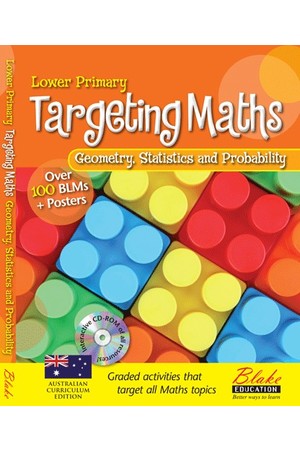
Targeting Maths - Teacher Resource Books: Lower Primary - Geometry, Statistics and Probability
Now $30.80


